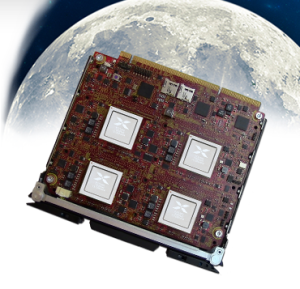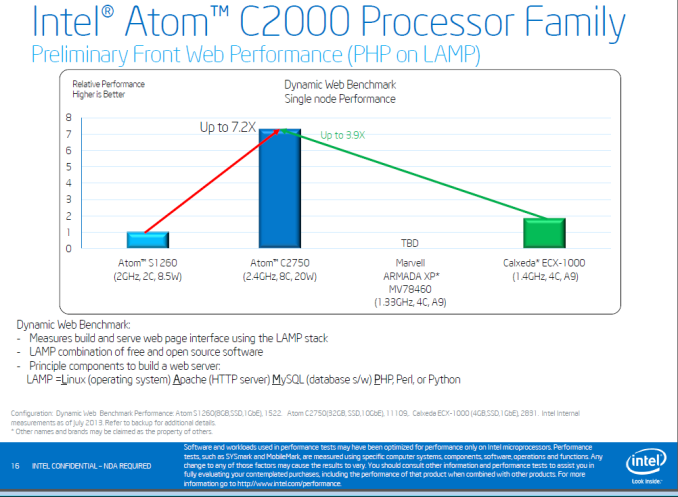The Next Generation of Micro Server SoCs: ECX-2000 vs Atom 2000
by Johan De Gelas on October 29, 2013 5:59 AM EST- Posted in
- Enterprise
- Intel
- Arm
- Calxeda
- Avoton
The benchmarking team of Intel Portland did their best to produce some really interesting benchmarks at the last server workshop in San Francisco, but many of the benchmarks did not work well on the ECX-1000 due to the very limited 4 GB RAM capacity. The most interesting benchmark can be found below: a front end web performance benchmark with high network traffic.
In this benchmark, Intel finally admits that the S1260 is nothing to be excited about. The Intel findings are very similar to ours: the ECX-1000 beats the the Atom S1260 by a wide margin in typical server workloads. So where will the ECX-2000 end up? We can not be sure, but we can roughly estimate that it will land somewhere between being 3 to 4 times faster than the Atom S1260. That is not enough to beat the Atom C2750, but that is after all a 20W TDP chip and the top SKU. Digging deeper in the Intel docs, we find that the C2730 at 1.7 GHz (12 W TDP) consumes about 20W for the whole server node (16 GB and 250 GB HD) and the C2750 about 28W when running SPECint_rate_2006. The harddisk will have consumed very little, since the SPECint_rate_2006 benchmark runs out of memory.
The ECX-2000 at 1.8 GHz will probably need roughly 12-16W per server node. So our first rough estimates tell us that the C2730 is out of the (performance) reach of the ECX-2000, and that Calxeda's estimate of the C2530 is right on the mark.
However, the story does not end there. The total power consumption of the ECX-1000 based Boston Viridis server we tested was remarkably low, the very efficient network fabric made sure there was little "power overhead" (PHYs, Backplane,...). This Fleet Fabric has been improved even further, so there is a good chance that the ECX-2000 based servers will offer a very competitive performance/watt, although the Atom C2730 has an edge when the application benefits from more threads. But when that is not the case, i.e. scaling is mediocre beyond 4 threads, the tables might turn. Anyway, there is a very good chance that the ECX-2000 is very competitive with the 4-core Atoms, to say the least.

There is indeed a reason why HP will use the Calxeda SoC in its new Moonshot server cluster in 2014. The picture above shows such a moonshot module. We felt that the Atom S1260 SoC was a bad match for the HP moonshot, but "HP's Moonshot 2.0" will be an entirely different story. And for those of us with less cash to burn we are looking forward what Penguin computing and Boston will make off their ECX-2000 based server.
Next stop, the 64-bit SoC code-named “Sarita,” based upon the 50% faster Cortex-A57 core, which is pin-compatible with the ECX-1000 and new ECX-2000. This reduces development time and expense for the ODMs. But right now, we can look forward to some interesting microserver comparisons in Q1 2014...











45 Comments
View All Comments
davegraham - Tuesday, October 29, 2013 - link
Johan, what will additionally be interesting is AMD's Seattle cores launching around the beginning of next year. the multi-core ARM architectures, integrated FreedomFabric and 10GbE on SoC, etc. will be a powerful combination. those too will be integrated into Moonshot. (heck, even the AMD X-series compares pretty well here...)JohanAnandtech - Wednesday, October 30, 2013 - link
Looking forward to that AMD's Seattle too. I hope however that they will not be limited to the current SeaMicro boxes: those servers are extremely well designed hyperscale servers, but they are a massive investment for a large part of the market (most of our readers :-). Few of the web services providers are willing to shell out so much money (see Google, Facebook's minimal servers)hoboville - Tuesday, October 29, 2013 - link
These low power high core count processors like the C2730 are interesting for SOHO NAS units. The core count and RAM capacity are also really interesting for VM platforms that use simple point of sale interfaces, since they aren't demanding in terms of calculation performance. Also, blade racks for virtualizing call centers and basic productivity remote desktops would see a boon from a high RAM and core count setup.There's a lot of potential, but they only support VT-x so advanced VM setups need not apply. Kind of disappointing, but I guess they want you to buy into Xeon. Still beats ARM though in terms of capacity (RAM, cores, etc).
JohanAnandtech - Wednesday, October 30, 2013 - link
The RAM capacity is still very limited for VM platforms. Two low voltage Xeons can offer up to 384 GB, 768 GB with LR DIMMs.theduckofdeath - Wednesday, October 30, 2013 - link
64GB available for 8 lightweight cores is more than enough, I think. It's not like these systems will be used for heavy duty stuff like a Xeon-based server.dylan522p - Tuesday, October 29, 2013 - link
Why did you ignore the Xeon that is Silcermont based?JohanAnandtech - Tuesday, October 29, 2013 - link
I am not sure what you mean but I fixed the table where Silvermont moniker was missingdylan522p - Tuesday, October 29, 2013 - link
Ya sorry. That was ignorance on my part.pikeike - Tuesday, October 29, 2013 - link
Anyone know of any small (around nano-itx or pico-itx sized) boards that have Intel Atom Rangeley chips and dual GigE ports? I don't need any video out. A serial port is good enough for the project I'm planning on doing.Thanks!
idos422 - Tuesday, October 29, 2013 - link
The smalled Silvermont based board with dual GigE I've found is this nano-ITX one using the embedded versions (Bay Trail I): http://www.portwell.com/products/detail.asp?CUSTCH...Too bad it has the GPU in it that's going to go unused. I'm sure this industrial application targeted board will probably cost the same as a larger Haswell based setup.